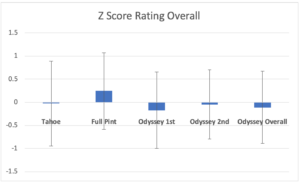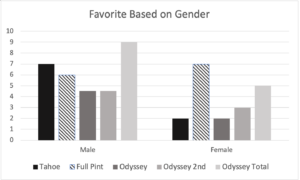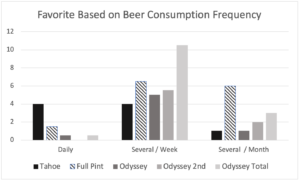Final report for FW18-027
Project Information
California growers are susceptible to commodity price fluctuations. One option in alleviating
commodity price stress is seeking out higher-value alternative crops. An ideal option for
California is malting barley as it can replace wheat as a winter grass in crop rotations and
typically fetches a higher price per acre than wheat.
As the craft brewing industry develops in California and malt houses begin to spring up in the
state to meet the demand for locally-sourced barley, California growers stand to benefit from
varieties of barley that are regionally specific to the states diverse ‘terroirs’. Growth in the
malting barley industry also increases the chances that growers will cover their fields with a crop
in winter rather than leaving land fallow if wheat prices are too low. This can provide numerous
benefits related to reducing soil erosion, runoff, and nitrate leaching into groundwater.
This project will bridge the gap from farm to glass in evaluating both agronomic and brewing
performance of five different malting barley varieties grown in the same agronomic
conditions with carefully controlled malting regimes.
Thereby this project aims to:
• Provide information and data which will reduce market entry barriers for growers,
improve grower capacity to produce quality malting barley, improve grower ability to
negotiate stronger contracts, and in conjunction with University of California’s Statewide
variety trials, select more appropriate varieties for their conditions;
• Provide additional data to maltsters and brewers to build industrial capacity in the region;
• Participate in a public awareness campaign to raise awareness among consumers of the
role that different varieties of barley play in their beverages.
By using available tools to meet the challenge of developing markets and uncertain commodity
prices, growers stand to benefit as the local craft brewing grows.
1) Generate supplemental data to ongoing statewide variety trials in growth, yield, disease
resistance, and post-harvest grain quality of four varieties of California-appropriate
barley and one variety of heritage malting barley (Klages malting barley).
2) Malt four varieties of malting barley in different 2000lb batches with different kilning
regimes (pilsner malt, pale malt, 8 Lovibond Munich, 30 Lovibond Chocolate).
3) Brew separate beers styles with each of the five varieties according to standardized
brewing practices (i.e. helles lager, pale ale, India pale ale, amber/red, stout…).
4) Quantify tasting notes from panel of cicerones.
5) Evaluate final barley/ beer combinations for key brewing quality factors. Primarily:
extract yield, pH, residual sugars (% and profile), stability, FAN, protein, and turbidity.
6) Publish brewing results in 2-3 popular brewing periodicals, and among 2-3 large
California periodicals to generate public interest and awareness.
7) Present agronomic findings to growers at UCCE grower meetings throughout the state;
8) Present malting/ brewing findings to the craft brewing industry;
Cooperators
- - Technical Advisor (Educator and Researcher)
Research
Five varieties of malting barley were planted into Yolo clay loam on November 9th of 2017 in a randomized complete block design. Seeding rates were calibrated for 1 million individuals per acre, but actual seeding rates varied due to limitations in the precision of on-farm machinery.
| Variety | Seeding Rate |
| Full Pint | 1.06 million |
| Genie | 1.1 million |
| Klages High Population | 1.31 million |
| Klages Low Population | 1.05 million |
| Odyssey | 1.11 million |
| Tahoe | 1.25 million |
The barley was harvested from the 25th to the 26th of June of 2018. Barley was cleaned at the Foundation Seed Program in Davis and shipped to a maltster capable of handling the capacity of the harvest (Gold Rush Malt in Baker City, OR) on August 13th, 2018. Samples of each of the varieties were sent to two separate labs (Hartwick College, USDA) for analysis. This data was used by the maltster to make minor adjustments in the malting process. Samples of barley were sent again after the malting process to produce a final malt quality report for reference by brewers. Barley was malted at intervals from the time of arrival until being shipped back to Chico (Sierra Nevada) and Davis, CA on the January 9th, 2018. Due to malfunctions in the malting process (a broken belt in the malting drum), one of the barley varieties was not malted uniformly with the other varieties and so cannot be compared from a brewing standpoint.
It will still be used by local breweries for Sacramento's Beer Week from May 10th until the 20th.
During the course of the season, a field day was held with growers, brewers, and maltsters. 18 participants were able to see the barley in the field and network with other industry representatives. Farm advisors and UC Specialists gave short presentations on findings related to barley cultivation (nitrogen management, lodging, protein, water stress) and future project goals. Barley growers shared their experience regarding soil moisture, protein, grain damage at harvest, sprouting, and appropriate pricing.
Before and after malting, samples were sent to Hartwick College for testing and quality analysis. The initial results from Hartwick College (pre-malting) were sent to the maltster to give the maltster some indication of relative germination times of each of the barleys. This would help ensure that barley would be malted to modification standards that were as close as possible in spite of variations in germination rates.
Two Consumer preference surveys were conducted in 2019. One at New Helvetia Brewing Company on April 28th, comparing Tahoe, Full Pint, and Odyssey varieties in a blonde ale. A second was conducted at YOLO Brewing Company on July 12th, comparing Klages (a ‘heritage’ variety), Tahoe, Full Pint, and Odyssey varieties in an American pale ale. The primary questions were:
1) All other things being equal, can consumers tell the difference between beers brewed with different types of malting barley?
2)Do consumers consistently prefer a certain variety of barley malt in their beer?
The growing season began with rains in early to mid-November before a dry period that lasted into early January and another dry period until the beginning of March. Late-season rain was brought rainfall totals for the winter up to 9 inches. Despite early season stress, barley protein was ideal for malting quality in all varieties. This may have been due to the fact that initial soil moisture was likely somewhat high following seed melon harvest.
Yields were measured using freight scales at UC Foundation Seed Program. Standard error was not available because subsamples were not collected during harvest, although varieties were separated.
Yields for the varieties are as follows:
| Variety | Seeding Rate | Yield |
| Full Pint | 1.06 million | 4574.33 |
| Genie | 1.1 million | 4121.57 |
| Klages High Population | 1.31 million | 2599.28 |
| Klages Low Population | 1.05 million | 2493.32 |
| Odyssey | 1.11 million | 4876.43 |
| Tahoe | 1.25 million | 4663.86 |
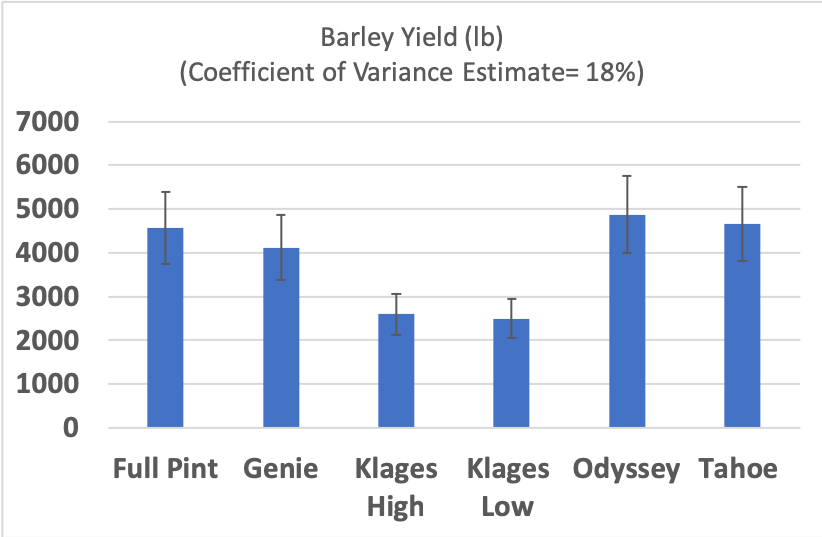
Another wheat experiment that was harvested in the same field produced a range of coefficients of variance (COV) between 2% and 18%. Assuming a very conservative 18% error in the barley experiment, the significant differences in yield are only apparent between heritage varieties (Klages High/ Klages Low) and modern varieties. Only at about 6% error does Odyssey outyield Genie (but is still insignificantly different from Tahoe and Full Pint).
Lodging rates were highest in the high-population Klages (45-50%). But were similar in the low-population Klages (40-50%). Better lodging rate measurements were confounded by regular N-rich areas in each of the plots due to residual nitrogen from the previous crop. Lodging was almost 100% in areas where seed melons had been gathered into windrows during the previous season. Lodging was still high in lower-N areas, but the rates dropped off in between windrows. Soil N values in windrow areas prior to planting were greater than 20ppm Nitrate-N, outside of those areas, values were <20ppm. These numbers are estimates based on soil sampling throughout the acreage at the beginning of the season. It wasn't until later in the season that the variability became apparent as plants matured. Modern variety lodging was less than 5%.
These results indicate several things: in these soils and with this climate, modern varieties can be planted between 1 million and 1.25 million individuals with minor lodging risk if pre-plant soil nitrate-nitrogen levels are below 20ppm. Furthermore, protein levels turned out to be reasonable despite early-season stress. This may have been due to significant late-season rains that allowed plants to build up their carbohydrate stores (although this assertion would require additional research).
Malting results indicate that there are variety-driven differences between the different barleys, particularly in factors such as beta-glucans, alpha-amylase, and friability. These data are important in informing brewers of what varieties they are looking for, which, in conjunction with yield and protein data can help growers better determine how they should approach their growing operations.
Malting quality when 4 varieties of barley were treated to average germination times and kilning conditions (detailed below):
Barley was malted in two separate instances :
1) By the Center for Craft Food and Beverage at Hartwick College under standardized conditions.
| STEEPING CYCLES: 8 hrs Wet (16 hrs Air) 8 hrs Wet (12 hrs Air) @ 14° C |
| GERMINATION: 96 Hours @ 15°C |
| KILNING: 6 hrs @ 55°C, 6 hrs @ 65°C, 6 hrs @ 72°C, 4 hrs @ 85°C |
Malted barley was tested for moisture, friability, extract (dry weight fine ground basis), wort color, beta glucans, soluble protein, soluble/ total protein, free amino nitrogen, diastatic power, alpha amylase, clarity, and pH (Below).
Malting quality following malting at Gold Rush Malting; slight variations in germination time were used to achieve (as much as is possible) uniform modification:
Distinction
New Helvetia:
Consumers at New Helvetia Brewing Company were asked to identify which two beers (out of four, where one was a duplicate) were the same. Of consumers surveyed 11 of 41 (27%) were able to distinguish which two beers were made with the same variety of barley. The chances of randomly selecting the correct pair were 17% (1 in 6 possible combinations), a 59% increase above random chance.
YOLO Brewing Company
Consumers at YOLO Brewing Company were asked to identify which one beer was different from two additional beers (triangulation). Of consumers surveyed, 18 out of 39 (46%) were able to distinguish which beer was different. The chances of randomly selecting the correct pair was 33% (1 in 3 possible choices), a 40% increase above random chance.
Both of these tests seem to indicate that a significant amount of people can tell the difference between beers brewed with different barleys; however, these data alone don’t indicate the relative rates of detection when compared to other ingredients in a beer such as hops, water, or even malt roasting degree (SRM).
Additional findings of note are that those consumers who had heritage grain (Klages) in their tasting panel were 16% more likely to tell the difference among their beers correctly (9/18=50%) compared to those who only had no beer made with heritage grain in their tasting panel (9/21=43%). Considering the agronomic difficulties associated with growing Klages grain (roughly 50% lower yields, higher disease incidence, and greater lodging percentage), the costs may not be worth it for most brewers/ maltsters.
Preference
Because different beers were rated against each other in the different panels, the results from New Helvetia and YOLO Brewing will be presented separately:
NEW HELVETIA
When variety ratings were converted into a z-score there was no singular variety that received significantly better ratings than the next. Full Pint trended higher than other varieties and Odyssey fared better after it was tried a second time as a duplicate (Table). However, when the top score was converted into a ‘favorite’ Odyssey, which had two entries, was favored over the other varieties (14), with slightly more people rating it as their highest pick when it was tasted for the first time rather than as a duplicate (Table). Full Pint was the second-most well received with 13 participants calling it their favorite. These numbers are arguably problematic due to the fact that there was a duplicate of Odyssey within the tasting.
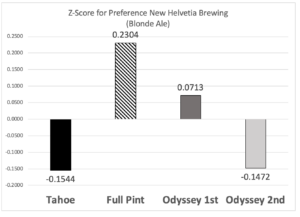
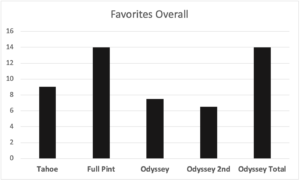
When favorite beers were counted based on different demographic information, the only significant differences were observed in gender. Male preferences leaned toward Odyssey, females preferred Full Pint.
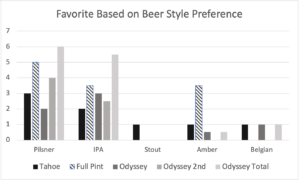
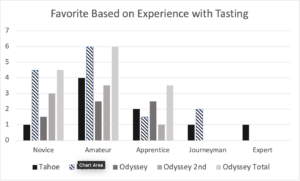
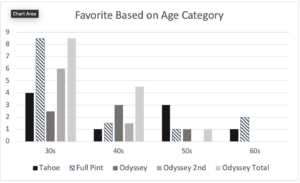
YOLO BREWING
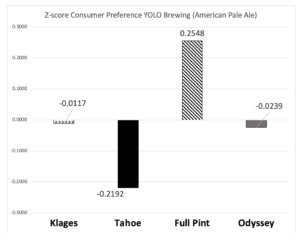
The results of these data suggest that the barley variety (modern and heritage) contributes to differences in the flavor of a beer. These results are not entirely certain due to the difficulties associated with malting an identical malt from different varieties. Each variety of barley requires longer or shorter germination times to reach similar levels of modification and behaves differently in the kilning stages (by picking up more or less color, for example). Moreover, data indicate that not every consumer is capable of distinguishing between differences in beer that stem from the barley variety itself. From the tasting trials it is suggested that between 27% and 43% of consumers are able to identify different beers brewed with different varieties of barley.
Other variables in the brewing process such as yeast and hops are typically the most distinguishing characteristics of beers, but barley, as malt, both in the malting regime and in the variety itself likely also causes subjective differences for individual consumers. This is reflected in the fact that consumer favorites were highly variable among different demographic and experiential factors. The existence of divergent preference among individuals would suggest that brewers, if their business plan includes the creation of new or different varieties of beer, are in a position to experiment with alternative varieties of barley in their brews.
Research Outcomes
Education and Outreach
Participation Summary:
Consultations: Growers have called into the UC Cooperative Extension Office or spoken with Konrad Mathesius at meetings regarding an interest in growing barley. Conversations typically included discussion of planting density, nitrogen rates, and varietal selections that have been successful in their area as well as information leading to other UC resources for more general barley growing information.
General Outreach: Data from these trials was integrated into the University of California's small grains website which is accessible by the general public. General varietal information has been shared widely through presentations of multi-site data at 4 meetings throughout the year (presentations by Mark Lundy). Specific results on barley trials were shared at 3 additional presentations in program summaries by Konrad Mathesius 1 for academics, 2 for growers.
On-Farm Demonstration: During the middle of the season, a field day was held on May 8th, 2018 for growers and industry representatives (millers, brewers, seed suppliers) to network and discuss some of the difficulties associated with barley. Growers were able to observe shattered spikes, disease pressure, lodging, and some of the visual effects of different Nitrogen rates (a nitrogen-rich strip was integrated into the field as a reference point). Other growers shared their experience with attendees including fertility management programs, combine speed settings, weed problems, spray timing, and post-harvest issues.
Field Day Discussions: A project update was given during a wheat and barley field day in April 2019 (15 participants) and the Small Grains Field Day in May 2019 (67 participants).
Website and project continuation: All data gathered through the project is being uploaded to the Malt Project Website (https://ucmaltproject.home.blog/). This will be serve as a reference for future questions related to malting barley in California. At the time of this writing I am still waiting on additional data from Sierra Nevada for the final tasting panel notes (although we have significant data from the first round of brewing, which has been posted).
Additional public outreach was conducted at several breweries as mentioned above: Taste testing events at local breweries (2: New Helvetia Brewing 45 participants, YOLO Brewing 53 participants) and an additional panel discussion with brewers, maltsters, consumers, and growers at Alaro Brewing Co. Two of these events took place during Sacramento Beer Week.
NPR Write-Up of Local Barley in California: https://www.kvcrnews.org/post/uc-researchers-work-perfect-california-sourced-ingredients-craft-breweries#stream/0
UC ANR's project team put together a press release for general public consumption: https://www.youtube.com/watch?v=klbYHr9zrS0&feature=youtu.be
Education and Outreach Outcomes
Due to a lack of experience working with this crop, this project was unable to provide detailed information regarding the behavior of barley in regard to:
Lodging: What planting density and nitrogen rates cause lodging in heritage varieties? How do planting density and nitrogen drive lodging when in modern varieties in conditions found in California?
Protein: What planting density and nitrogen rates are optimal for maximum yield and high quality? This project helped confirm a safe amount of nitrogen, but did not scale nitrogen to generate a curve (particularly to maintain quality consistency for later portions of the project). However, projects answering this question specifically are being run by a grad student at UC Davis. The findings will be integrated into small grains resources available to growers from UCANR.
Disease: 2017-2018 was a low-pressure winter/ spring for barley in the Southern Sacramento Valley. A bad year may amplify yield differences between varieties. Multiple years of data on disease pressure will be gathered from Statewide Variety Trials with the University of California.
While this project was able to replicate taste testing trials with slightly different approaches (coming to similar conclusions), there are a lot of variables in the process from planting to pouring the final pint. It cannot be said with 100% certainty that the conclusions are rock-solid, but they do seem to indicate reliable trends in data that can begin to help stakeholders within the supply chain make more-informed decisions. Agronomic data and grower interaction with the crop helped break down initial barriers for growers, some of whom commented that they would be including malting barley as an option moving forward.
Farmers gained a better understanding of what barley yields can be expected in this area on high-quality soils.
From group discussions at the field day, farmers learned about the importance of (and factors associated with) keeping protein levels optimal for brewers. And that excessive protein can lead to outright rejection of grain. This necessarily motivates careful planning and use of nitrogen, as it is one of the primary drivers for protein percentage in grain.
Farmers witnessed first hand the difference between high and low nitrogen barley (specifically they were shown how a nitrogen-rich area can help serve as a reference for barley's in-season nitrogen status and health).
Farmers learned about the risk of lodging in older heritage varieties and the need to carefully control nitrogen and planting density through the use of soil sampling and equipment calibration, respectively.
Farmers learned about the growing potential for malting barley as an alternative crop in California (when wheat prices are low).
Maltsters and brewers gained a better appreciation and understanding of the risk factors associated with barley cultivation. This should inform risk calculations in price negotiations. Maltsters and brewers also learned about some of the differences in barley varieties (i.e. malt is not simply a product of the kilning process, but also the variety and even the climate/year in which it was grown).
Consumers learned that malting barley varieties can make a difference, but also gained an appreciation for the subtlety of that difference. This hands-on experience will also help brewers weigh up whether or not it is worth worrying about which specific variety of barley they should be brewing with. This provides some guidance regarding consumer preference, but also gives some weight to the argument that growers in California should just be growing what works best for them because only about 27-46% of consumers can tell the difference between barley varieties, and some of that could be due to raw chance.
Consumers and potential entrepreneurs gained an awareness of barley's role in a popular beverage as well as the possibility for locally grown barley in California. This public consciousness may help build markets moving forward.
Farmers, brewers, maltsters, and consumers reviewed or augmented their knowledge of malting quality parameters.
Information Products
- The Malt Project (Website)
- The Malt Project: 2018 Updates (Conference/Presentation Material)


